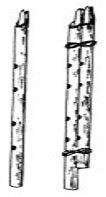The material and structure of the dong flute
The traditional Dong flute is mostly made of water bamboo, but also made of purple bamboo, golden bamboo or yellow withered bamboo. The length and thickness of the flute are not fixed.

Dong flutes generally have a tube length of 30 cm to 40 cm and an inner diameter of 1.3 cm to 1.5 cm. In addition to the slope-shaped mouthpiece at the upper end, a bamboo joint is left or a flute plug is blocked, the lower end is open, and there are six sound-pressing holes on the pipe body.
When making, usually use the bamboo cut in August, choose the bamboo with a longer distance and a more uniform thickness. After drying in the shade or steaming, use the thicker end as the mouthpiece, and first open the tube body 5 cm away from the upper end. A square sentinel hole (also called pronunciation hole or sound window), the hole is 1 cm long and 0.8 cm wide. Then split a bamboo skin on the pipe wall just above the sentry hole, trim and cut off 3/4, to form a rectangular groove with a depth of 0.15 cm and a width of 0.8 cm. The sheet is wound and fixed with bamboo strips or thin wires to form an air intake channel. The thin bamboo pieces of the whistle are used as air distribution valves, and are also fixed to the lower half of the whistle through bamboo strips, making it a whistle. On the tube body below the whistle, there are six circular sound-pressing holes vertically. The distance from the lower nozzle to the first hole is completely equal to the circumference of the lower nozzle, and the distance from the whistle to the first hole is 1/2. The sixth hole is opened, and four sound holes are opened between the first hole and the sixth hole, and the six sound holes are arranged equidistantly.
 渝公网安备 50010702504639号
渝公网安备 50010702504639号